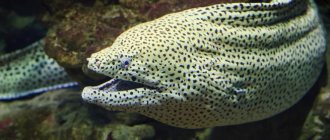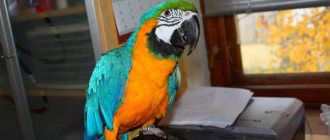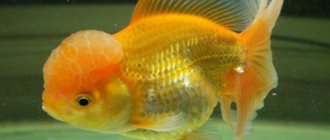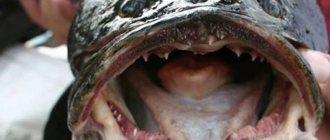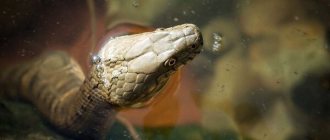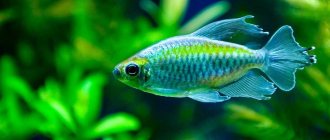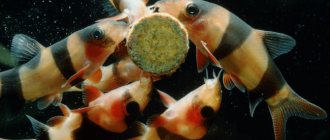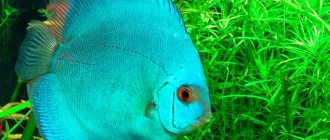Transparent fish got their name due to the lack of reflective scales and the ability to transmit light through themselves. This feature helps them not only hide from predators, but also preserve valuable resources in their natural habitat. To date, many of their species have been studied, some of which have become popular among aquarists.
- 1 Mr. Tail Recommends: Varieties
- 2 Description and natural range of the Transparent Perch
- 3 How to decorate an aquarium with glass fish
- 4 Basics of aquarium keeping
- 5 Compatibility
- 6 Feeding
- 7 Breeding
- 8 Diseases and prevention
Mr. Tail recommends: varieties
Transparent fish are found among different families of marine life. The following have become popular:
- Indian perch (Parambassis ranga) has a body of 8-10 cm, along which a purple stripe stretches. In males it is olive in color, and in females it is silver. Breast feathers are red.
- The largemouth bass (Parambassis pulcinella) is distinguished by a rounded outgrowth that hangs over the forehead. The oval body (8 cm) is flattened at the sides. The scales are golden with chaotically scattered dark spots.
- Threaded perch (Gymnochanda filamentosa, Glass angel) is distinguished by a body up to 3 cm in length and thin fins. There are dark stripes on the sides, and large eyes on the reddish head.
- Indian catfish (Kryptopterus vitreolus) grows up to 10-15 cm. In the lower part there is an anal fin along the entire length. There is a pair of mustaches on the head. Its African cousins have longitudinal black stripes and 4 barbels on the nose.
- Tetra (Prionobrama filigera) has a translucent grayish body with a longitudinal green stripe. It is very elongated, reaches 6 cm and ends with a blood-red tail.
- The ridley pristella (Pristella maxillaris) is called star-shaped due to its golden color with yellow-black stripes on its fins and a red tail. Its body is 4-4.5 cm, high and flattened on the sides.
- The glass knifefish (Eigenmannia virescens, Glass Knifefish) resembles a blade and grows up to 30 cm long. With age, it acquires color and an electromagnetic field. An anal fin runs along the body, but the others are absent.
- Charax condei has a diamond-shaped body of a golden hue, covered with dots and strokes, with a longitudinal stripe. Grows up to 7 cm long. He himself is a predator, and invisibility helps him in the hunt.
There are also small Amazon fish, the amazing Smallmouth micropinna with a translucent head, Golomyanka native to Baikal, consisting of 35% fat. Due to their structural features, they are unsuitable for home breeding, but they never cease to amaze with their beauty. In addition to fish, jellyfish, glass frogs and squid, Indian shrimp, mollusks Angelfish, Salpa Maggiore and sea cucumber have an unusual structure.
Photo gallery of Transparent fish:
New Zealand miracle
Fisherman Stuart Fraser near the Karikari Peninsula came across an unusual creature. At first he mistook it for a crumpled plastic bag that was slowly sliding along the surface of the water. Only after looking more closely did Stuart realize that it was a living organism. Until that time, the fisherman had not encountered anything like this in sea waters and at first did not dare to take the animal in his hands.
However, the man's curiosity prevailed over fear. He extracted a very strange and completely transparent fish from the water. Her body was covered with flimsy, jelly-like scales. That is why the transparent fish looked more like a jellyfish. All the internal organs of this amazing sea animal were practically invisible, except for one small teardrop-shaped one, painted red. Fraser took several photographs of the amazing fish and released it back into its native element.
Description and natural range of the Transparent Perch
The species and geography of distribution of Transparent fish around the globe are so diverse that it is simply not possible to describe them all here; this requires separate articles for each species.
Here is a description of the most popular aquarium pet from the Glass Fish series.
This representative of the Okunev family has a number of characteristic features:
- Through the transparent matte body, 25 vertebrae, gills and entrails, covered with a shiny protective membrane, are visible.
- The flat body has a diamond shape with a slightly concave forehead, which gives smooth movement.
- The dorsal fin changes from a triangular part to a rounded part, which is symmetrical to the anal part.
- The swim bladder located near the belly is pointed in males, while in females it is rounded.
This description makes it possible for perches to camouflage themselves, hiding from predators. In their natural environment they can be found in the following bodies of water:
- Indians, native to India and Pakistan, prefer rivers, streams, lakes and swamps, standing or with a slight current, with dense vegetation.
- Bigheads live in fast-water rivers and streams of Myanmar or Thailand, preferring an active lifestyle.
- The filamentous species are native to Southeast Asia and live in peat bogs and river marshes in Malaysia.
As you can see, such animals prefer fresh water to sea water, which makes home breeding much easier.
Sea glass
In order to survive, fish are forced to camouflage. Stripes and spots on the fins and body, different colors of scales, as well as various outgrowths help them blend into the background that surrounds them. But there is one very extravagant and easiest way to become invisible in the water. This is to become transparent, as if dissolving in one’s native element. To lose color, a marine animal only needs to lose a reflective surface, for example, mirror scales.
After all, it is a well-known fact that glass lowered into water is practically invisible to the human eye. This method of camouflage is also chosen by a wide variety of fish that live in the seas and in fresh water bodies. Moreover, these species often have no related relationships with each other. “Glass” fish are also found among aquarium fish.
How to decorate an aquarium with glass fish
The water environment should not only be beautiful, but comfortable and safe for its inhabitants. To ensure this, you need to follow these instructions:
- Pour dark river sand or crushed polished gravel onto the bottom to replace the soil.
- Place driftwood from mangrove trees, artificial houses, caves and other interior elements suitable for shelter.
- For Glass Angels or Tetras, you can add oak or beech leaves and branches to bring the conditions closer to natural.
- Densely plant plants accustomed to salty water, such as hornwort, fern, vallisneria, and Java moss.
- Provide bright lighting for Perch and Catfish, and dim lighting for Kharacinovs, with shaded areas.
The abundance of vegetation and decorative items will not only allow the fish to hide, but will also help them to have privacy during the mating season.
Reviews
Some aquarists have been disappointed to learn that colored specimens do not live long and quickly lose color. Fans of perches note that the pets look unusual in the aquarium and are easy to breed, as evidenced by numerous photos and videos.
Aquarium Basics
To provide your pets with optimal care, it is worth maintaining certain water quality indicators and regularly filtering and aerating it. It is also necessary to replace 10% of the liquid daily with pre-settled liquid.
| Name | Number of fish | Min. aquarium volume, l | Water parameters | ||
| t °С | pH | gH° | |||
| Indian grouper | 6-15 | 50 | +20…+27 | 6,5-8,5 | 8-20 |
| Bighead Bass | 6-10 | 50 | +24…+27 | 7,0-9,0 | 5-15 |
| Threaded perch | 8-10 | 100 | +20…+28 | 4,0-6,0 | 1-5 |
| Indian catfish | From 6-8, better 10-20 | 150-200 | +23…+26 | 6,5-7,5 | 5-6 |
| Glass Tetra | 6-12 | 70 | +22…+28 | 6,0-7,5 | Up to 15 |
| Pristella ridley | From 6 | 50-70 | +23…+28 | 6,0-8,0 | 2-30 |
| Charax Conde | 6-10 | 80-100 | +23…+25 | 6,0-7,5 | 3-10 |
| Glass knife | From 5 | 200 | +20…+30 | 6,0-7,0 | 2-15 |
Some representatives of the Okunev and Somov families are initially accustomed to brackish water. If necessary, you can adapt to new parameters by placing purchased pets in quarantine and gradually diluting the liquid in the container.
Charax Conde
This relatively large fish comes as close as possible to the “glass” ideal. Her tall, diamond-shaped body has a slight golden hue.
The transparency of this fish is not used at all for camouflage from enemies. The fact is that the charax itself is a predator. In order to wait for prey passing by, this fish is capable of spending long hours in ambush. Its transparent body makes it invisible in water. In this case, the charax hangs absolutely motionless in the thickets of aquatic vegetation with its head down.
Compatibility
Transparent fish are schooling by nature. But not all of them tolerate neighbors of other species. For example, it is appropriate to keep perches with catfish, tetras, bee gobies, zebrafish, bots, nannacaras and rasboras while providing a fresh environment. In salted water, it is better to place them next to guppies and mollies. Neons, small cichlids or gouramis, swordtails and minors are also considered reliable neighbors for catfish.
In turn, the Glassy Perch does not like neighbors, so their presence should be minimized. The same can be said about Charax Kond, but for different reasons. This is a predatory fish that should be kept in a species aquarium.
Price
The cost of glass aquarium fish varies depending on the type and store. The average price starts at 90 rubles per piece. Purchases are possible through online stores with delivery or in regular pet stores.
Transparent fish are exotic pets with a pleasant appearance that can be a good choice even for people without much experience in keeping fish. Some consider their appearance strange and frightening.
What do you think? Share your opinion in the comments.
Feeding
In the natural environment, transparent fish consume live food, so when bred in aquariums, dry food will not be popular with them, and in some cases will lead to infertility. In general, you can diversify their diet with frozen bloodworms, daphnia, small crustaceans, tubifex, coretra or cyclops.
Catfish and perch prefer floating food, which is due to the structure of their mouths. They pick up food from the bottom clumsily, lying on their sides. Fry can be fed with specially formulated microflakes or small bioplankton.
An amazing inhabitant of Baikal waters
Unusual creatures are found not only in the seas and oceans. For example, there is transparent fish in Baikal. This is an animal that does not have a swim bladder or scales. Additionally, thirty-five percent of his body is fat. This fish lives at great depths in Lake Baikal. Its individuals are viviparous.
What is the name of the transparent fish of Lake Baikal? Golomyanka. This name comes from the Russian word "golomen", meaning "open sea". It surprisingly accurately conveys the existing features of the etiology of this species of fish.
Golomyanka has thinned skull bones. She has especially developed dorsal, pectoral and anal fins. Golomyankas are very prolific. One individual is capable of producing almost two thousand fry. Reproduction occurs through gynogenesis, which is typical only for this species.
The transparent fish of Baikal can withstand enormous pressure equal to one hundred and twenty-five bars. This is the only reason why its habitat is the bottom of this deep reservoir.
Fish feed using a passive method. Golomyanki literally float in the water with the help of their pectoral fins. At the same time, their mouth is constantly open and is able to instantly grab passing food in the form of benthic amphipods, Epishura and macrohectopus and other food.
It is believed that golomyanka fat was used in ancient times as lamp oil. This transparent fish played a major role in Chinese and Mongolian medicine. During wars, it was caught in order to restore strength to wounded soldiers.
Breeding
Transparent fish reach maturity at 4-6 months of life. Under optimal conditions, they are able to reproduce by laying eggs in secluded corners of plants. The ratio of males and females should be 1:2.
The most suitable time for this is early spring or late autumn, when the food becomes most nutritious for the fry.
During this period, you can add floating vegetation to the aquarium and provide a spawning space of at least 50-80 cm for one or several pairs. The water needs to be changed regularly and lightly added, and its temperature must be increased a couple of degrees.
After spawning, the female and male should be transplanted into another container. The incubation period is 3-4 days, and then the fry appear, which within 3 months grow by 1.5 cm. Change the water for them carefully, introducing it by drip. Lighting needs to be constant, as are other parameters.
A new species of reservoir inhabitants?
Stuart Fraser showed photographs of the amazing creature to Paul Kast, director of the National Marine Aquarium. After studying the photographs, he determined that this creature was none other than Salpa Maggiore - a transparent fish. This species is similar in appearance to jellyfish, but nevertheless has a close relationship with marine vertebrates.
Salpa Maggiore is a transparent fish (see photo below). However, it has a heart and gills. In addition, there are special filters inside this fish. They pass water through its body, collecting food in the form of phytoplankton and algae.
Salpa Maggiore is a transparent fish that travels in large groups. The peculiarity of this species is that individuals of this creature have no gender. They are able to independently produce offspring, forming massive schools.
Salpa Maggiore is a transparent fish (the photo confirms its unusual appearance), and it looks like a creature from a horror movie. However, you shouldn't be afraid of her. This is an absolutely harmless creature that feeds on planton. The transparent body is only a camouflage that can protect the fish from attacks by sea predators, which, like it, live in the surface layers of water.
Very little information has been collected about the Salpa Maggiore fish. Scientists attribute it to one of the subspecies of salsa, numbering about thirty species. In addition, these marine invertebrates are known to prefer to live in the cold waters of the Southern Ocean.
The transparent fish Salpa Maggiore has a barrel-shaped shape. It moves through water by pumping fluid through its body. The jelly body of the fish is covered with transparent scales, through which the annular muscles and intestines are visible. On the surface of the unusual creature you can see two siphon holes. One of them is oral, leading into the large pharynx, and the second is cloacal. The openings of the siphons are located at opposite ends of the transparent body of the fish. On the ventral side of the sea animal is the heart.
Diseases and prevention
Fish diseases penetrate through damage to the skin from the outside. In particular, after artificial dyeing of fabrics, which is used by some sellers. It shortens the lifespan of pets by up to a year.
Among the most common pathologies are:
- Ichthyophthyriosis (“white dot”, “semolina”) is caused by the ciliates ichthyophthirius multifiliis. The first signs are white bumps all over the body and lack of oxygen. Malachite and Diamond greens, Violet K (Chlorohydrite) are suitable for therapy.
- Fin rot (pseudomonosis) occurs due to Pseudomonas bacteria, which develop when the temperature drops and the biological balance is disturbed. Manifests itself in the form of rot on the fins. It is treated with Tripaflavin (1:10000), Morphocycline and silver nitrate.
- Lymphocystis (lymphocystis) is caused by the LCDV virus. Manifestations include warts and nodules on the fins, skin and gills. It goes away within a few weeks under suitable conditions.
Treatment should be carried out by a qualified veterinarian. And in order to prevent pets from getting sick, a number of preventive measures should be taken:
- Quarantine purchased fish for up to 0.5-2 months.
- Replace up to 25% of water every week.
- Clean glass and decorations from deposits.
- Plant excess fish without allowing overcrowding.
- Remove traumatic decorative elements.
- Feed regularly 1-2 times a day.
Creating optimal conditions that are close to natural will avoid many problems. And careful attention to pets will ensure their maximum life expectancy of up to 3-4 years.
